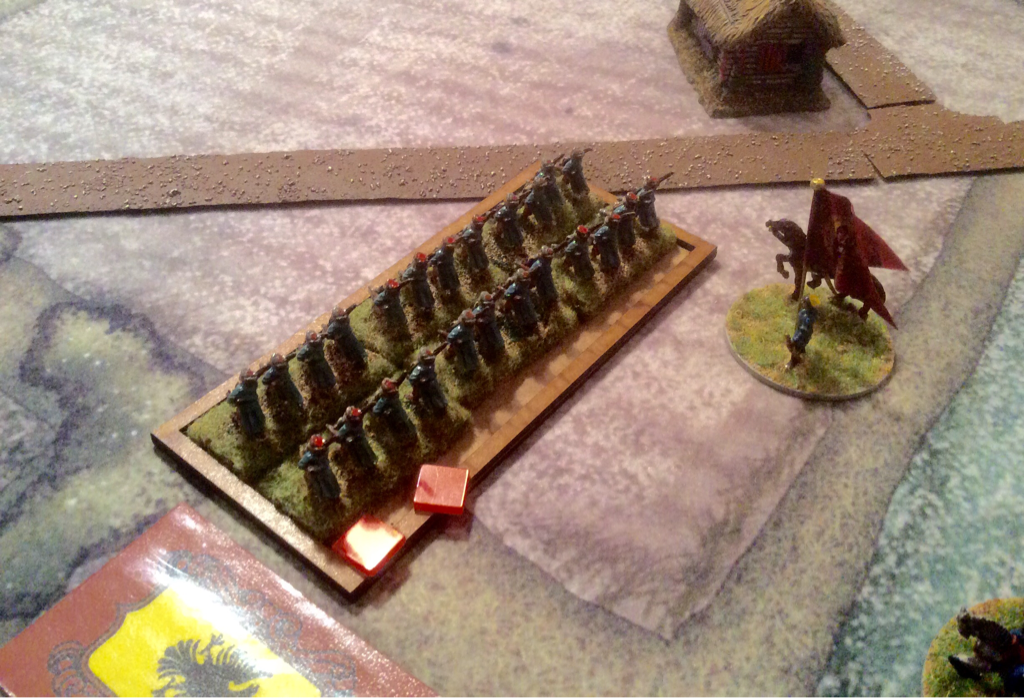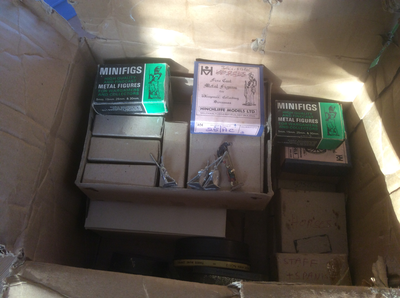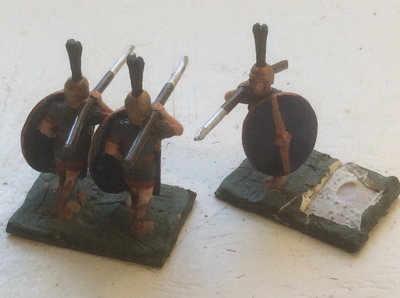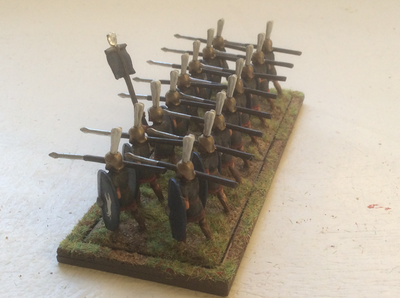|
Our first run through of the Tercios rules had a varied selection of troop types to see how they coped under the rules. We played turn one collaboratively, placing order counters face up and discussing their expected effects. From turn two we placed orders face down but still agreed to set up some particular situations to see how they played out.
Our conclusions were: It is great fun and quick to learn. Placing orders really makes you think about your force. The reaction function of each order enlivens the game no end and allows opposing units to interact naturally and convincingly. For example, some Polish Hajduks assaulted a unit of Registered Cossacks, who fired at them as they closed, inflicting some damage but not enough to stop the attack. However, the Attack in turn wasn't as decisive as it could have been so the Hajduks disengaged. Cavalry combat can be brutally quick, especially if lances are involved. The rules for commanders seem a bit complicated and there are a great many traits available to choose from. I expect they will feel less complicated with experience and it is welcome that commander models have a real part to play in the game. But I'm pretty sure already that we will outlaw some of the more 'magical' traits, which behave almost like Warhammer spells. Kingdoms The Kingdoms supplement has some interesting rules to suit Eastern armies, such as the ability of Tatar bowmen to fire and evade. The Tabor and Gulay Gorod are well represented and Polish Hussars are suitably powerful but not superhuman. I had reservations about some of the interpretations of Eastern troop types. For example, Polish Pancerni are billed as heavy, presumably because their name means 'armoured' in Polish. But these troops were no more heavily armoured than Hussars and indeed were originally known as Cossacks: they only acquired their new name after the start of the Khmelnytsky rebellion to distinguish them from Cossack insurgents. Another thing that puzzled me was the absence of Cossack infantry besides the Plastun skirmishing companies. These companies can be converted to Tabor but this isn't enough: I expected to see stats for Registered and Zaporozhian Cossack Infantry as well. The Cossacks were mainly infantry armies at this period, having the reputation of producing the finest infantry in the region. Registered Cossacks constituted some of the Polish army's best Foot regiments, when they weren't in rebellion! And they did not always fight from wagons. I was therefore a bit disappointed but not for long. With these rules it is easy to adapt the stats to suit your own prejudices. So I made up my own stats for formed Cossack infantry, drawing on Musketeer and Hajduk stats, and simply dropped the Pancernis' heavy status. The verdict after first play? Very positive. PS I have gone into a bit of detail because superficial rules reviews are a pet hate. But if I have banged on for too long please excuse me - and let me know, so I don't repeat the mistake in future.
0 Comments
Summary for the skim reader: Tercios is elegant, fast moving, full of period flavour and great fun to play. Kingdoms provides essential extra rules and army lists for Eastern Europe and the ECW. A free PDF of the basic rules is available at
http://elkraken.es/released/en/. Give it a try. Mechanics On 24 February we ran through a quick action using Tercios and its supplement for Eastern Europe and the ECW, Kingdoms. It was an interesting and decisive encounter. I found the rules much easier to demonstrate than describe. Each unit has a whopping 10 factors on its Stats line, each used for a different situation. 6 of these are 'active' factors and 4 are used by the enemy in different fire and melee situations. Before you walk off in disgust, this is the most complicated element of the rules and the engine of the system is elegant, simple and intuitive. Speed is a basic allowance in inches. Every other active factor represents the number of six sided dice to be thrown against that quality. An increase or decrease in a factor reduces the number of dice to roll: the target number doesn't change, just the number of dice you are rolling. We learned pretty quickly what we needed to roll for each test. It helps to have played Dreadball, which has a similar system. Each turn begins with the selection of orders for each unit on both sides. The options are Ready, the vanilla order allowing any two actions from a short list including fire at reduced effectiveness; Assault, with increases to speed and melee factors; Run, putting everything into speed; Fire, allowing a salvo at full effect; and Resist, which allows a unit to recover damage. Each card also has a Reaction function that can be taken as an interrupt when enemy either declares an assault on the unit or moves within 3". The reaction on a card can be subtly different from its Order, so for example Musket-armed foot who fire as a reaction to an enemy charge receive a bonus that they wouldn't have got had they fired as an action. However, a unit must pass an order check to react that it might fail, so deciding when to activate a unit can be a tricky challenge. Players then roll for initiative and one of them selects the first unit to activate. If a unit has suffered no damage this is automatic, but any unit with at least one 'wear' point must pass an Order check. I mentioned above that wear markers can be removed with the Resist order, but one hit always sticks so once damaged, a unit will have to test to obey orders for the rest of the game. The effect of this simple mechanic is pleasing: control and army cohesion become harder to maintain as the action develops. Movement is very simple but satisfyingly clunky for the formations represented. Measurements for this and for firing are all made from the centre points of the unit. You need to plan your moves carefully as exposed flanks are very vulnerable. I like it that without imposing strict limits on dispositions, the rules work best for the player whose army deploys along historical lines. Shooting and melee have similar mechanics. The active player rolls a number of dice equal to its relevant modified factor and compares the results to the target's defence factor. Every die that equals or exceeds this factor scores a hit. The target then takes a Courage test and every roll of 5 or 6 saves one hit. Unsaved hits convert to wear markers. A target whose total of wear markers equals its stamina becomes weary and loses effectiveness. If it receives more wear markers than its stamina it must take a break test, needing to roll a 6 to overcome each point over its stamina. In melee, the target unit fights back with the same procedure and the winner is determined by a comparison of the total wear markers inflicted. A melee can result in one side disengaging by retiring 3"; retreating with backs to the enemy; or breaking completely. In both firing and melee, certain circumstances can disorder a unit, with a drop in effectiveness. Oops. Getting carried away. Review to be continued in next blog. I have been working my way through a project to rejuvenate some very old Minifigs Republican Roman 25s. They came my way after the widow of Marius, a childhood opponent of my friend Keith, asked if he would find homes for her husband's figure collection. Keith knew I already had several Minifigs figures and offered me a big box of Romans, Spaniards and Carthaginians. He remembered gaming with these figures in the 1970s, although they had evidently spent many years on a shelf, replaced by more modern projects. Rediscovering these old castings has been great fun. I am not expert in the history of Minifigs but I believe this collection is from their penultimate (or original?) range, which had certainly been phased out when I started collecting ancients in 1981. They are even smaller than 'true' 25s, especially the horses, and the detail is superficial. However the proportions and poses are good and I find the look en masse very pleasing. It turned out on inspecting the box that there were more unpainted than painted models in Marius' collection. I started by rejuvenating the painted models, all of which were of Hastati/Principes holding pilum over-arm. They had shiny blue shields with copper bosses and strips and were based in old style with filler painted green. I made up three new units of 16, leaving one of them with blue shields as a link to their past livery. Most of the repainting was of shields, plus an Army Painter soft tone wash on the flesh and bronze paint on helmets. After repurposing the painted models I started creating new units to supply a respectable Republican Army for Sword and Spear. I found that I have a huge number of Triarii Spearmen, but no more troops with Pilum to reinforce the front line. I created a fourth Hastati/Principes unit by shortening the spears of a Triarii unit and inserting brass rod in the tops to provide the long shank of a pilum. I am pleased with the result. I will use other surplus Spearmen to create allied legionaries. I have kept the paint jobs on new units simple and compatible with the older figures. The shield transfers are by Veni, vidi, Vici. I think they look impressive, even with telegraph pole spears, and if wanted to go super detailed, I shouldn't be using 1970s figures in the first place. I have also completed a unit of Carthaginian Spearmen, holding shields with bosses, as they were portrayed back in the 70s. I know today's thinking is that bosses would have made fighting in a phalanx uncomfortable, but they look good, reflect the received wisdom of the day and that's enough to earn a place on my table.
This has been a really enjoyable exercise and I am glad Keith thought of my interest. I hope Marius would feel that I have kept to the spirit of his army and that he would be pleased to know they will keep on fighting for, I hope, another several years. So here's to the memory of Marius and to the pleasure of getting veteran wargame figures back onto the gaming table. The other day I bought Tercios, the translation of a Spanish rule set that caught my eye at Warfare in Reading. It is a cracking rules system. The smallest unit is a Foot company or Horse squadron, with frontages being 12cm for large and 8cm for smaller units. Losses are accumulated as 'wear' points and there is no figure removal, so any basing system will work.
Units have various factors that mostly convert to the number of dice rolled to conduct a certain function. Dreadball players will recognise the approach: if, for example, a unit with discipline 4 wants to obey an order, 4 dice are rolled and as long as at least one rolls a 5+, the unit can proceed. Each turn, both players allocate order cards to their units and activate them alternately. Each order card has two possible functions, depending whether it is used for an activation or for a reaction. Certain cards give bonuses to different factors, so charging troops, for example, receive an increase in combat dice. These rules are carefully considered, elegant and intuitive once you get the hang of the basic concepts. The only aspect that I am not so sure about is the very wide range of qualities that are available to choose from for commander figures. There are so many that I end up confused by all of the nuances and possible combinations. They feel a bit like unnecessary chrome and my solution so far has been to ignore all but the simplest ones. The game plays fine without them and indeed, the free download of the rules from the el kraken website doesn't include them. This week I have received my copy of the supplement Kingdoms direct from Captain General in Spain. It adds many new options for the ECW and for armies in my beloved East European theatre The book is in Spanish and I have needed to use the dictionary here and there, but having a copy of Tercios in English helps a lot. I love the way the authors tackle the particularities of Eastern European warfare: Gulay-gorod, Tabor, Tatar horsemen, etc. are all represented neatly and without over complicating the rules. I also like the open-ended nature of unit construction: I can make this unit veteran, give that unit muskets, arm these horse with lances and so on. These rules deserve to be widely known outside Spain. I do hope somebody is writing an English translation of Kingdoms as I am sure they will be a success. Later this month we will be using Tercios/Kingdoms to replay the first encounter of the 1660 campaign in Ukraine, at Lubar. I am looking forward to seeing how they play in a multi-player game. On 3 February Ian, Matt and I fought a three player Longstreet game, using a rebooted version of the Macpherson's Ridge scenario (available here). I have slightly amended the set-up to allow the action to hot up sooner than previously. I have also tidied up the map. I played the Confederates, while Ian and Matt each led a Union brigade. Figures are 12mm by Kallistra. The game begins as Buford's cavalry retires through the advancing 1st Division. Archer, on the Confederate right, raced the Iron Brigade to the ridge and just reached the crest first. Davis on the left assaulted Oak Hill on the Union right and his eager recruits piled straight into Cutler's position, with mixed results. One regiment bowled over the opposition and then routed an Iron Brigade regiment in column that was marching to reinforce Cutler. The other regiment was held by the Federals and quickly started losing bases. Even so, in the middle game the balance of losses was markedly in favour of the rebels. The situation changed conclusively over the last two turns. First, the Iron Brigade assaulted Archer and while this was tough, they had the better of the combats. Then the Federals played the 'Couldn't hit an elephant' card, rolling a 6 and so completely denying the Rebels a turn. In their next turn the Iron brigade continued their attack and the Confederates hit Break point. Losses at the end of the game were 25 Federals and 29 Confederates. It was another great game in which the Elephant card was played at an ideal moment. Ian had been holding it since his very first replenish and he timed its use perfectly.
|
Archives
November 2023
Categories
All
|













 RSS Feed
RSS Feed